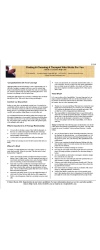Probing Questions Grease The Wheels Of Conversation
How And Why To Use Probing Questions
Whether you are shy or outgoing, talkative or quiet you can become a brilliant conversationalist by learning to use, and using probing questions.
What Are Probing Questions?
Probing questions (Probes) are follow-up questions used after someone makes an initial response. A probe isn’t a “new” questions, because the content of the probe is directly based on the other person’s initial response.
For example:
John: Did you vote for Trump in the last election? (initial question)
Sue: Yes, I did
John: So, are you satisfied with your vote? Would you change it if you had a chance? (Probe)
Sue: No, I think we need to give him a chance, and I think Clinton would have been a disaster.
John: So you voted as much to prevent Clinton from being elected than from liking Trump? (Probe)
Sue: Yes, kind of. It was a bad set of choices.
John builds conversational momentum by asking questions that are directly related to the previous answers Sue made.
The Power of Probes
Before we talk about the different kinds of probes, take a look at the power of probes to achieve a lot of interactional goals.
Probes…
- show you are interested in the other person, and paying attention.
- show you are curious and want to understand the other person.
- help you understand in more depth what the other person is saying.
- are useful in teasing out common ground when there is disagreement.
- lubricate the conversation. If you have trouble thinking of things to say in conversations, you can always ask a question, then follow up with probes to get the conversation going.
- are useful in helping the other person think through what they are saying in more depth. (the teaching/socratic function).
- help you determine if you have heard the other person correctly and accurately, and know what they mean.
- in groups useful for involving other less active members and bring others into a conversation.
Types of Probes
Probes can be open ended or closed ended (yes, no). Open ended ones are good at getting people to open up, while closed ended ones are useful for concise rapid fire confirmation of what has been said.
Redirect: Redirect probes involve asking a follow up question to others present or observing the conversation. For example: “Fred, have you gone to Mexico for vacation just like Sam?
Clarification and Expansion: Useful to get additional information the other person hasn’t offered up, and to keep the conversation going.
Verification: A verification is, in effect a feedback loop – a way of confirming that you are understanding the other person. For example: “So let’s see if I have this right. You are saying that…” Am I understanding you?
Relevance: Sometimes when a person is speaking, you may lose the logical thread of his/her points. A relevance probe involves asking how the person’s last remarks pertain, or are relevant to the discussion.
Affective: Affective probes aren’t about the substance of what’s said, but about the speaker’s emotional reactions or feelings about what he or she has said, or believes. A typical and simple example: “How do you feel about that?
Why Probes: Why probes ask the speaker to justify their position or explain it further. They can put the other person on the defensive, since people tend to become resistant to why questions particularly if emotions run high.
There are other types of probes, but these are some of the most important. Types can vary from author to author, but if you’d like another list of probe types, along with examples, check out Changing Minds.
Probing Question Tips
- You’ll notice that these questions don’t involve “I”. That’s because probes are about learning about the other person, rather than adding your own viewpoint, opinion or experiences.
- A conversation shouldn’t consist only of probing questions. You’ll probably want to add in your own “stuff” to a conversation, but most conversation is ME centered anyway. Remember that people love to talk about themselves, so if you encourage them to do so, and show genuine interest, they’ll gravitate to you.
- Obviously, you need to LISTEN to the responses you get. Most people, while in conversation, think about their next contribution to the discussion rather than truly listen. This interferes with understanding. Stay in the moment.
- Avoid rapid fire pacing of probes. You need to give people the chance to think and answer, but you also want to prevent the conversation from sounding like an interrogation.
- Your body language and tone will often determine whether you are using probes (and questions) as a way to manipulate, or a way to understand further.






